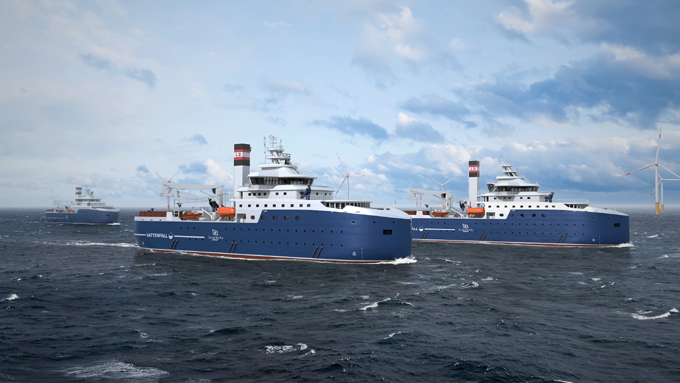
Vattenfall has signed a contract with French ship owner Louis Dreyfus Armateurs for up to three large Service Operation Vessels to be used at existing and planned offshore wind farms in the North Sea.
The 90 meter Service Operation Vessels will be used to support offshore wind farm operations and maintenance in the North Sea from 2027.
Today, Vattenfall mainly uses so called Crew Transfer Vessels (CTV) at its offshore sites. These are smaller and used for daily transport of technicians to and from the turbines if the sailing times are short. For more far offshore windfarms, the much larger Service Operation Vessels (SOV) are better suited as they are built to stay on the site for several days.
These vessels also feature spacious and comfortable hotel standard living quarters with a focus on rest and relaxation during standby periods. Each vessel can carry 60 people excluding the vessel crew.
Reduced fuel consumption
The vessels will be built, owned, and operated by French GroupLouis Dreyfus Armateursand will be registered under the French flag. The ships have been specifically designed to reduce fuel consumption and emissions during both operations and transit while meeting the harsh conditions of the North Sea.
Special care has been taken to enhance the safety and efficiency of the workflows and ensuring that technicians have optimal working conditions. For example, the vessels will have an adjustable-height stern boat landing to optimise technicians’ safe transfer between the ship and the turbines.
“After a thorough tender process we are really happy to have concluded these 10-year contracts and starting a long-term cooperation with Louis Dreyfus Armateurs,” says Pavlo Malyshenko, Head of Offshore Generation at Vattenfall Wind. “The vessels will support our mission of safe, reliable, and sustainable operation and delivery on cost efficiency ambitions in Sandbank and DanTysk, as well as the coming Nordlicht 1 and 2 wind farms. This will strengthen competitiveness of our far offshore wind assets and our position as one of the leading wind developers and operators in Northern Europe.”
The first vessel will be put into service in mid-2027 on the existing DanTysk and Sandbank offshore wind farms, each with a 288 MW capacity. The second vessel will be used for the coming Nordlicht 1 and 2 wind farms, co-owned by BASF, with a combined total capacity of 1,6 GW. The Nordlicht cluster is subject to final investment decision. A third, optional Service Operation Vessel is intended use in future Vattenfall projects.
Sandbank Offshore wind farm
The offshore wind farm comprises 72 Siemens wind turbines in the 4-megawatt class. With an overall capacity of 288 megawatts, the wind farm provides green power to supply up to 400,000 households. The wind farm extends over an area of 60 square kilometres and is located 90 kilometres off the coast of Schleswig-Holstein, right next to DanTysk. The Offshore wind farm has been finalized in 2017.
The Sandbank offshore wind farm is the second joint project between Vattenfall and Stadtwerke München. The two companies have already jointly implemented the DanTysk wind farm.
The wind farms DanTysk and Sandbank benefit from an unique concept in the North Sea and will share an offshore accommodation platform, located in the midst of DanTysk. And this is not the only benefit, the three offshore wind farms Horns Rev, DanTysk und Sandbank achieve enormous synergies by using the same vessels, infrastructure and facilities managed from the service harbor in Esbjerg.
DanTysk offshore wind farm
The entire wind farm covers an area of 70 square kilometers and is located 70 km off the North Sea island of Sylt. Due to the curvature of the earth, the wind farm is not visible from the island. The wind farm comprises 80 wind turbines of 3.6 MW from Siemens. With a total output of 288 megawatts, up to 400,000 households can be supplied with climate-friendly electricity. The rotor diameter is 120 meters and the tip height reaches 148 meters. The foundations are monopiles, which were installed in water depths of 21 to 32 meters. The first foundation was installed in February 2014 and the wind farm produced its first kilowatt hour in December 2014.
A total of 88 power cables with a total length of 108 kilometers (the so-called inner park cabling) transport the power from each of the 80 wind turbines initially on the 33kV AC voltage level to the wind farm's own substation. From there, the alternating current reaches the so-called converter station of the grid operator Tennet at a higher voltage level of 155 kV. In order to transport the electricity over a distance of about 200 kilometers as loss-free as possible to shore to Büttel (in Schleswig-Holstein) the alternating current in the Tennet converter station is converting back into direct current.
Nordlicht 1 and 2 wind farms
In April 2024, Vattenfall agreed the sale of 49 percent of their Nordlicht 1 and 2 wind farms to BASF. The two companies are thus deepening their partnership in the field of renewable energy.
Vattenfall is responsible to develop and construct the Nordlicht sites and intends to use its share of future electricity generation to supply customers in Germany with fossil-free electricity. BASF will use their share to supply its chemical production sites in Europe, especially in Ludwigshafen.
KeyFacts Energy Industry Directory: Vattenfall
 KEYFACT Energy
KEYFACT Energy